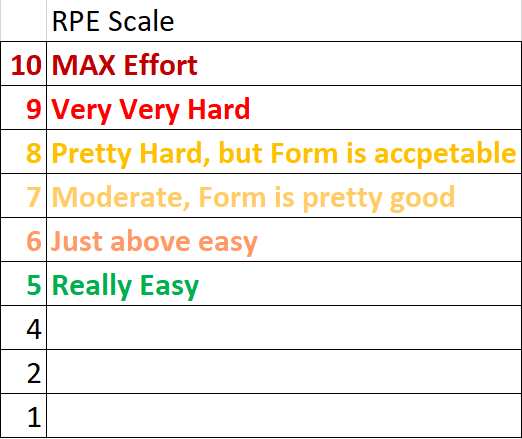RPE is rated perceived exertion. It can be used to gauge a set performed. For example, you do a set of squats and you rate the difficulty level as a 7 out of 10. This means subjectively you were working at 70% maximum effort. Of course, there are many factors involved in your rating system. As you use the rating system over time and get objective feedback on this system you are able to calibrate it to be more accurate.
RPE Scale
A few ways to calibrate it is watching video of yourself after you rated it. If it moved better than it felt then you may want to reduce the rating by ½ value. If you think it felt easy but the speed looked really slow then you may want to increase the rating by ½ - 1 value
Repetition verses Singles
The further away you get from a true 1 RM the more subjective the scale becomes. This is imparted due to the different energy systems that use and the amount of objective data. In a set of 20 reps (glycolytic and oxidative) if you were close to a 10 RPE you’d be able to hold the weight for a couple of seconds and you can probably do another rep adversity in a set 1 rep (phosphocreatine) at an RPE 10 no matter how much rest you take you would not be able to do any more sets of 1 and even at a slightly lighter weight.
Hitting the wall
Finding the wall helps you calibrate your scale for both ends of the spectrum. If you are doing an as many reps as possible set and you have muscular failure at rep 12 then you know that’s an RPE 10. If you deadlift 365lbs and try 385lbs and miss, it can be inferred that RPE 10 is somewhere between 370-380lbs.
Words of Caution
This is a subjective system and needs to be used with a grain of salt. Your rating system needs to time to develop. When it develops into a reliably source you can then use it to fine tune your ability to recover (keep RPE under 7) or to push you beyond you limits (go to RPE 9.5). Like any system it has pit falls and the biggest one it requires lifters to develop a high level of awareness. To get started just observe and rate your sets. Take video and ask yourself “do I agree with what I initially rated that set?”. Change you RPE if it doesn’t line up. Do a test. If it’s a safe movement to fail on and want to test out your RPE rating, do one additional set and take it to failure. If you’re doing 15 more reps then your work weight, well you are probably going too light. Remember to be safe, use failure points as ways to identify your boundaries and keep practicing it!

